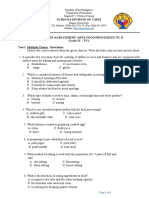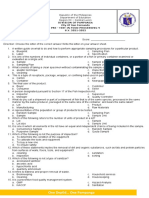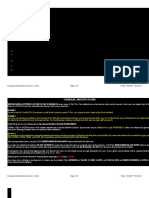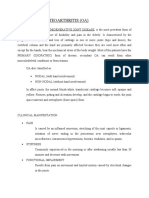100%(2)100% found this document useful (2 votes)
635 viewsFood Processing Question
Food Processing Question
Uploaded by
Airesh Shene Enanoria EltagondeThe document provides information about tools, equipment, and processes used in food fish processing. It includes a multiple choice quiz about measuring devices like refractometers and salinometers, tools used for cutting and handling food, specifications for tools and equipment, sanitation procedures, and quality control practices.
Copyright:
© All Rights Reserved
Available Formats
Download as DOCX, PDF, TXT or read online from Scribd
Food Processing Question
Food Processing Question
Uploaded by
Airesh Shene Enanoria Eltagonde100%(2)100% found this document useful (2 votes)
635 views5 pagesThe document provides information about tools, equipment, and processes used in food fish processing. It includes a multiple choice quiz about measuring devices like refractometers and salinometers, tools used for cutting and handling food, specifications for tools and equipment, sanitation procedures, and quality control practices.
Copyright
© © All Rights Reserved
Available Formats
DOCX, PDF, TXT or read online from Scribd
Share this document
Did you find this document useful?
Is this content inappropriate?
The document provides information about tools, equipment, and processes used in food fish processing. It includes a multiple choice quiz about measuring devices like refractometers and salinometers, tools used for cutting and handling food, specifications for tools and equipment, sanitation procedures, and quality control practices.
Copyright:
© All Rights Reserved
Available Formats
Download as DOCX, PDF, TXT or read online from Scribd
Download as docx, pdf, or txt
100%(2)100% found this document useful (2 votes)
635 views5 pagesFood Processing Question
Food Processing Question
Uploaded by
Airesh Shene Enanoria EltagondeThe document provides information about tools, equipment, and processes used in food fish processing. It includes a multiple choice quiz about measuring devices like refractometers and salinometers, tools used for cutting and handling food, specifications for tools and equipment, sanitation procedures, and quality control practices.
Copyright:
© All Rights Reserved
Available Formats
Download as DOCX, PDF, TXT or read online from Scribd
Download as docx, pdf, or txt
You are on page 1of 5
FOOD FISH PROCESSING
Direction: Read the question carefully. Choose the letter of the correct answer.
1. Which device is used to measure the strength of brine solution?
a. Salinometer c. Both a and b
b. Thermometer d. Refractometer
2. What is the function of the refractometer?
a. Measures the sugar content of sap and syrup c. Wraps the food/fish for processing
b. Measures the temperature of the food/fish d. All of these
3. What is used in measuring the volume of liquid?
a. Salinometer c. Refractometer
b. Cylinder d. Thermometer
4. What is the standard measuring instrument used in fish processing?
a. Salinometer c. Thermometer
b. Fefractometer d. All of these
5. What type of water is used in calibrating refractometer?
a. Distilled water c. Water from the faucet
b. Sea water d. Brackish water
6. A device used to measure the weight of fish/ food is?
a. Thermometer c. Measuring Cups
b. Weighing scale d. Measuring spoon
7. A device used to measure the temperature of the fish/ food is?
a. Weighing scale c. Thermometer
b. Measuring cups d. Measuring Spoon
8. It is used for cutting or slicing fish or meat: for scaling fish
a. Food tong c. Spatula
b. Chopping/cutting board d. Knives
9. It is use for picking up or handling food
a. Spatula b. knives c. Food tong d.chopping Board
10. Food tong are used for holding food, while storing the salted products used?
a. Earthen pots c. Wooden salting vat.
b. Oil drum d. All of these
11. What are some specifications included by the manufacturer of certain tool, equipment or
utensils?
a. Dimensions as to size, height, capacity, etc.
b. Handling and operating requirements
c. Proper care and maintenance
d. All of these
12. Why are specifications for food processing tool, equipment and utensils necessary?
a. Because they provide information to the user as to how they must be properly handled
and operated in order to avoid accident
b. Specifications give information concerning the proper use, care and maintenance of the
tools, equipment and utensils
c. Both A and B
d. Specifications provide information about the tools, equipment and utensils
13. If you are a food processor, why do you need to know the parts of the equipment, tools and
utensils and their functions?
a. To appreciate the usefulness of a particular device
b. To be able to correctly operate/manipulate a tool, equipment or utensils
c. To be able to do some simple repairs on them
d. To easily determine if a part is missing
14. If you’re going to pack processed foods in tin cans, why do you need to seal it with a can
sealer?
a. Cans cannot be sealed manually
b. Tin cans are difficult to seal
c. To properly seal them
d. A can sealer is the appropriate equipment for attaching the cover to the body of a tin
can with is first and second operations.
15. What will help you determine the kinds of tools, equipment and utensils you will assemble,
sanitize inspect or check?
a. The kind of product to be produced
b. The method of food processing to be done
c. The raw materials to be processed
d. The availability of tools, equipment or utensils
16. You have already removed the dirt from the tools, equipment or utensils you will use in
processing the food by washing them with soap and water. Why do you still need to
sanitize or disinfect them?
a. Washing with soap and water only removes the adhering dirt
b. Washing alone cannot remove effectively the microorganisms and germs
c. To effectively kill or destroy all germs and microorganisms which remained after
washing
d. None of these
17. Which of these is a sanitizing agent you can use for killing the germs and microorganisms
presents in tools, equipment and utensils?
18. How will you properly store tools, equipment and utensils after using them?
a. Wipe dry all tools, equipment and utensils which were washed with water before
keeping them
b. Stow them in a clean dry place with a good ventilation
c. Apply lubricant to parts of equipment that undergo friction to prevent wear and tear
d. All of these
19. Why do you need to inspect and check the condition of equipment and machines before
operating them?
a. To check if no parts are defective or missing
b. To check if electrical plugs are in good condition
c. Both A and B
d. To see if they are old or new ones
20. Which of this preventive machine maintenance will you check before using equipment or
machine?
a. Machine temperature and hydraulic fluid
b. Wear and surface condition
c. Crack and leak detection and electric insulation
d. All of these
21. If you buy ¼ kilo of sugar to be used in pickling how much is this in grams?
a. 250 g b. 260g c. 280g d. 265g
22. You are instructed to process fermented fish. What is the ratio needed to ferment fish and
salt by weight?
a. 1:4 b 1:6 c. 1:5 d. 1:8
23. In smoking fish, how many grams of salt is equivalent to one cup?
a. 250 g b. 260g c. 265g d. 280g
24. In your laboratory room, your group leader asks you to prepare the mixture for mango jam.
What is the proportion needed?
a. 1:1 and 1 : ¾ c. 1:3 and 1:1/4
b. 1:2 and 1: ½ d. 1:4 and 1: 1/8
25. Using 1:3 ratio in salting fish, how many grams of salt is needed to salt the fish weighing
900 grams?
a. 300 g b. 400 g c. 500 g d. 200 g
26. It is a systematic procedure of producing a record for reference
a. Outline b. production cost c. documentation d. input
27. It is something that enters a process from the outside and is acted upon or integrated in the
main body of data.
a. Production report b. output c. input d. documentation
28. Anything produced especially through a process; a product; a yield
a. Documentation b. input c. output d. production report
29. A written record showing the input output relationship in determining the yield from a
certain procedure.
a. Documentation b. production report c. output d. input
30. It is the process of capturing data or translating information to recording format.
a. Input b. output c. production report d. documentation
31. This processing activity involves pre-cooking.
a. Storing b. receiving c. preparation d. processing
32. This activity involves the final heal treatment during processing.
a. Sterilizing b. storing c. preparation d. labelling
33. This activity involves segregating suitable from unsuitable raw materials.
a. Grading and sorting c. receiving
b. Labelling d. preparation
34. The purpose of this activity is to give the correct information about the product
a. Storing c. processing
b. Labelling d. receiving
35. One purpose of this activity is to prolong the keeping quality of the finished product
a. Labelling c. processing
b. Storing d. preparation
36. How will you ensure the safety of raw materials particularly the quality of fish in processing
especially during handling?
a. By checking the source of supplies
b. By checking the quality of the fish
c. By monitoring regularly the preparation of fish
d. All of these
37. What is the purpose of applying strict quality control in choosing raw materials for
processing?
a. To prevent inferior finished products
b. To produced good finished product
c. To produces sound marketable products
d. All of the choices
38. In keeping equipment and facilities safe and sanitary, what must be considered?
a. Processing facilities must be well ventilated
b. Processing facilities should be adequately lighted and properly maintained
c. Processing equipment/facilities should be cleaned and disinfected before and after
using
d. All of the choices
39. Which among the choices includes practices and procedures implemented in processing
plants to ensure product safety, product quality and prevention of economic fraud?
a. GMP C. HACCP
b. SSOP D. None of these
40. Which of the following environmental hazards refers to the discoloration of bodies of water
due to the presence of an extremely enormous amount of “bloom” of a called din flagellates
which are toxic?
a. pollution b. fire c. flood d. red tide
41. Biological action, sedimentation, soil absorption, evaporation, and dilution are the principles
of:
a. Screening
b. Lagooning irrigation land disposal
c. Spray irrigation land disposal
d. Chemical treatment
42. What illness is acquired by eating contaminated food?
a. Air borne illness c. Skin illness
b. Food borne illness d. Lung illness
43. Which of the following refers to the science of good health that signifies cleanliness and
freedom from the risk of infectious diseases?
a. Hazards b. hygiene c. sanitation d. cleanliness
44. Why do personnel wash their hands wherein personal cleanliness may affect food safety?
a. At the start of food handling activities
b. Immediately after using the toilet
c. After handling raw food or any contaminated material
d. All of the above
45. Which of the following is the concern of personnel hygiene?
a. Freedom from any diseases
b. Wearing of clean washable garments
c. Observing sanitary habits and clan hands
d. All of these
46. Which of the following is not a GMP requirement on personnel hygiene?
a. Hazard analysis c. Illness and injuries
b. Health status d. Personal activities
47. Which of the following environmental hazards refers to a sudden rise, usually brief, in the
water level of a stream to a peak from which the water level recedes at a slower rate?
a. Fire b. flood c. chemical spill d. none of these
48. What is referred to as a rapid oxidation with evolution of light and heat?
a. Flood c. fire
b. Chemical spill d. all of these
49. What mitigation or preparedness should be made in case power interruption?
a. Have the flashlight c. both A and B
b. Have ready a gas lamp or candle d. None of these
50. Which of the following response should be done during chemical spills ?
a. Vacate the room
b. Avoid throwing water or touching the chemicals with bare hands
c. Inform proper authorities
d. All of these
You might also like
- Proper Dimaya National High School Grade 8 Food (Fish Processing)Document3 pagesProper Dimaya National High School Grade 8 Food (Fish Processing)Jomaima Angar90% (10)
- Food Processing - PPTDocument20 pagesFood Processing - PPTAngelie Rescallar100% (3)
- Food Pro. 9 PowerpointDocument33 pagesFood Pro. 9 PowerpointKrizel Legaspi75% (4)
- 1st Quarterexam On Food Processing Curing Salting SmokingDocument3 pages1st Quarterexam On Food Processing Curing Salting SmokingLyn nunez100% (2)
- First Quarter Exam TLE 7 - AFA-FOOD (FISH) PROCESSINGDocument4 pagesFirst Quarter Exam TLE 7 - AFA-FOOD (FISH) PROCESSINGSALGIE SERNAL100% (3)
- Activity Sheet Quarter 0 MELC 2: Tle-Afa (Food Processing)Document10 pagesActivity Sheet Quarter 0 MELC 2: Tle-Afa (Food Processing)Mari PagxNo ratings yet
- Pre Post Test Food ProcessingDocument6 pagesPre Post Test Food ProcessingRyl Mitch100% (3)
- G9 Summative TestDocument4 pagesG9 Summative Testmyline anecul100% (1)
- 2nd Grading Exam in TLE 9 FinalDocument2 pages2nd Grading Exam in TLE 9 FinalErma Jalem100% (4)
- Afa - Food Processing NC Ii - Grade 12Document5 pagesAfa - Food Processing NC Ii - Grade 12Paul Senen DiduloNo ratings yet
- First Periodic Test in TLE 10 Food ProcessingDocument2 pagesFirst Periodic Test in TLE 10 Food ProcessingEdsel L. Ramos82% (11)
- Food Processing NC II: Written ExamDocument4 pagesFood Processing NC II: Written ExamMary Yole Apple Declaro67% (3)
- Daily Lesson Log Weekly - Oct 28-31Document3 pagesDaily Lesson Log Weekly - Oct 28-31tin100% (2)
- Module-Food Processing10 (Week 2) Q1-A4Document9 pagesModule-Food Processing10 (Week 2) Q1-A4IlY-MyraTorresDeJesusNo ratings yet
- The Cryptojewish Revelation The Susite Lineage of King David, Moses and JesusDocument102 pagesThe Cryptojewish Revelation The Susite Lineage of King David, Moses and Jesusapi-333545603No ratings yet
- TLE10 HE Cookery Q1 m3 V3Document24 pagesTLE10 HE Cookery Q1 m3 V3Charmy Jane Padilla80% (5)
- Department of Education Schools Division of Aurora Ramada National High SchoolDocument3 pagesDepartment of Education Schools Division of Aurora Ramada National High Schoolmeriam cariagaNo ratings yet
- Exam 2020Document4 pagesExam 2020Shulamite EstevesNo ratings yet
- 4th Quarter Tle 8Document5 pages4th Quarter Tle 8Richard Empimo100% (1)
- PRETEST in Food Processing 9 Gerome TongolDocument3 pagesPRETEST in Food Processing 9 Gerome TongolGerome Tongol100% (3)
- G8 Fish ProcessingDocument3 pagesG8 Fish Processingcatherine botardo100% (1)
- Republic of The Philippines Department of Education Region VI-Western Visayas Division of Antique Barasanan National High SchoolDocument4 pagesRepublic of The Philippines Department of Education Region VI-Western Visayas Division of Antique Barasanan National High SchoolJesha Mae Tandoy PolesticoNo ratings yet
- Corresponds To Your AnswerDocument4 pagesCorresponds To Your Answermyline anecul67% (3)
- Diagnostic Test in TleDocument4 pagesDiagnostic Test in TleRaquel S. De CastroNo ratings yet
- 2nd Quarter Food ProcessingDocument3 pages2nd Quarter Food ProcessingJeziel Gapor100% (1)
- Summative Test in Food Processing: Exploratory Course in Grade 7 & 8Document2 pagesSummative Test in Food Processing: Exploratory Course in Grade 7 & 8Marycon Lao NacitoNo ratings yet
- Food Processing - 10 - Quarter2 ExamDocument8 pagesFood Processing - 10 - Quarter2 ExamLiza BanoNo ratings yet
- FOOD (FISH) PROCESSING TLE 8 Q1 With TosDocument8 pagesFOOD (FISH) PROCESSING TLE 8 Q1 With Toslorna t. orienteNo ratings yet
- G10 Summative TestDocument4 pagesG10 Summative Testmyline anecul75% (4)
- Food Processing DLL 01Document5 pagesFood Processing DLL 01Grahsie Abella Paño-GuertaNo ratings yet
- 1st Summative Test in Tle g8 Quarter 2Document4 pages1st Summative Test in Tle g8 Quarter 2John Mark Sandoy100% (1)
- 3 Periodical Test: Tle 9-Food ProcessingDocument2 pages3 Periodical Test: Tle 9-Food ProcessingLea Cardinez50% (2)
- Tle Summative Test Second Quarter 1stDocument3 pagesTle Summative Test Second Quarter 1stPascua Robelyn100% (1)
- Tle 8 Second Quarter Second Summative TestDocument2 pagesTle 8 Second Quarter Second Summative TestPascua Robelyn100% (7)
- Food Processing 10 Summative TestDocument2 pagesFood Processing 10 Summative Testsoy100% (2)
- Food Processing ExamDocument6 pagesFood Processing ExamErma Jalem100% (2)
- 2nd Summative Test TLE8Document3 pages2nd Summative Test TLE8lesterNo ratings yet
- TLE-DLL-FEB 27,28-March 3, 2023Document6 pagesTLE-DLL-FEB 27,28-March 3, 2023Florence IlaganNo ratings yet
- Diagnostic Test Food ProcessingDocument5 pagesDiagnostic Test Food ProcessingHoneyza NarzabalNo ratings yet
- Grade 7 Bread and PastryDocument6 pagesGrade 7 Bread and Pastryrussel silvestreNo ratings yet
- Tos.-Food Processing Grade 9Document4 pagesTos.-Food Processing Grade 9Gerome Tongol100% (2)
- Group 4 PPT Fermentation and PicklingDocument46 pagesGroup 4 PPT Fermentation and PicklingXynith Llanora Palacio100% (3)
- Food Fish Processing Module 1Document47 pagesFood Fish Processing Module 1Raneil Alvers100% (3)
- DLL Foodprocessing 1Document10 pagesDLL Foodprocessing 1Jessica MotarNo ratings yet
- Las Food Fish Processing in 8Document32 pagesLas Food Fish Processing in 8Jerodette Ann Ocop Ocena100% (3)
- TLE 9 Food ProcessingDocument34 pagesTLE 9 Food ProcessingJovet Moyano100% (8)
- Food Processing 9Document3 pagesFood Processing 9SHIRLEY JEAN SuganoNo ratings yet
- Learning Activity Sheets Food Processing Grade 9: Implement Sampling ProceduresDocument4 pagesLearning Activity Sheets Food Processing Grade 9: Implement Sampling ProceduresPrila100% (2)
- Food Processing Module Week2 Day5 8Document12 pagesFood Processing Module Week2 Day5 8scaredy catNo ratings yet
- Tle 7 Answer Sheet 7 & 8Document3 pagesTle 7 Answer Sheet 7 & 8Clark Domingo100% (5)
- Diagnostic Test (Tle Commercial Cooking)Document4 pagesDiagnostic Test (Tle Commercial Cooking)Chel Clemencio100% (2)
- Food Fish Processing 10-Q2-Week 3Document10 pagesFood Fish Processing 10-Q2-Week 3IlY-MyraTorresDeJesusNo ratings yet
- Tos Tle g9,10 3rd GradingDocument4 pagesTos Tle g9,10 3rd Gradingtee jay ramos100% (4)
- First Grading Food Processing.1Document40 pagesFirst Grading Food Processing.1anneNo ratings yet
- Grade 8 Module 7 TLEDocument2 pagesGrade 8 Module 7 TLEFerry May Manzon100% (3)
- Bow TleDocument2 pagesBow Tlekeren rose100% (4)
- Activity Sheet Quarter 0 MELC 1: Tle-Afa (Food Processing)Document13 pagesActivity Sheet Quarter 0 MELC 1: Tle-Afa (Food Processing)Mari Pagx100% (2)
- Module 1 Food ProcessingDocument3 pagesModule 1 Food ProcessingMarie Villanueva100% (1)
- Summative Test 7-!st Q. - WisdomDocument3 pagesSummative Test 7-!st Q. - WisdomReizle TinazaNo ratings yet
- Fourth Periodical Test in Tle 7Document2 pagesFourth Periodical Test in Tle 7JHOANNA SANGUYONo ratings yet
- TQ G8 FoodprocessingDocument5 pagesTQ G8 FoodprocessingChing ChaNo ratings yet
- 1st Periodical Examination Food Fish ProcessingDocument5 pages1st Periodical Examination Food Fish ProcessingShiela Marie GuillermoNo ratings yet
- Kulith - The Super Pulse PDFDocument5 pagesKulith - The Super Pulse PDFChandaniNo ratings yet
- Waiver and Release of Liability Form: Breakout Games - St. LouisDocument2 pagesWaiver and Release of Liability Form: Breakout Games - St. LouisReNae DealNo ratings yet
- Summary of The Seven Exchange ListsDocument9 pagesSummary of The Seven Exchange ListsChristine MatasNo ratings yet
- Microbial Diseases of The Respiratory SystemDocument30 pagesMicrobial Diseases of The Respiratory SystemChristopher Eria Santiañez0% (1)
- Advanced Financial Management: Tuesday 3 June 2014Document13 pagesAdvanced Financial Management: Tuesday 3 June 2014SajidZiaNo ratings yet
- General Instructions: Grading Worksheet Made by Raymond A. Gorda Page 1 of 17 Printed 7/30/2017 7:03:26 AMDocument17 pagesGeneral Instructions: Grading Worksheet Made by Raymond A. Gorda Page 1 of 17 Printed 7/30/2017 7:03:26 AMNimrodBanawisNo ratings yet
- 월든 1~5Document5 pages월든 1~5olwldmsloNo ratings yet
- 12M Battery-Electric BusDocument2 pages12M Battery-Electric BusКонстантин КосаревNo ratings yet
- Hail Mary : The Angelus (English)Document3 pagesHail Mary : The Angelus (English)Pierre TheilharDe Chardin100% (1)
- OsteoarthritisDocument5 pagesOsteoarthritisShienlee Villagonzalo LimNo ratings yet
- Research Proposal PDFDocument21 pagesResearch Proposal PDFRamraj Ronil SharmaNo ratings yet
- New Grove - WORD PAINTINGDocument4 pagesNew Grove - WORD PAINTINGR_P_Mcs100% (1)
- LK 1 Modul 6Document3 pagesLK 1 Modul 6Bunga MawarNo ratings yet
- Neuroform 3Document4 pagesNeuroform 3neureportNo ratings yet
- 5 6179277836549881993 PDFDocument72 pages5 6179277836549881993 PDFNazri RoslanNo ratings yet
- Marketing Plan FinalDocument15 pagesMarketing Plan Finalapi-301056313No ratings yet
- Flow Presssure EquationsDocument2 pagesFlow Presssure EquationsCharles BenwariNo ratings yet
- ScriptDocument6 pagesScriptkeithareola14No ratings yet
- RapeDocument7 pagesRapeCha Aisyah50% (2)
- Mfirstuc - Sty v2.06: Uppercasing First Letter: Nicola L.C. Talbot Dickimaw BooksDocument20 pagesMfirstuc - Sty v2.06: Uppercasing First Letter: Nicola L.C. Talbot Dickimaw Booksraul yondoNo ratings yet
- 03 Yeast Metabolism PDFDocument12 pages03 Yeast Metabolism PDFMlopezNo ratings yet
- Final Resume NehaDocument2 pagesFinal Resume Nehashikha dhimanNo ratings yet
- A Study On Marketing Strategies of HaldiramsDocument70 pagesA Study On Marketing Strategies of HaldiramsSUSUWALA50% (2)
- Internationally: Commerce Is The Activity of Buying and Selling of Goods and Services, Especially On A Large ScaleDocument2 pagesInternationally: Commerce Is The Activity of Buying and Selling of Goods and Services, Especially On A Large Scalekmsrini@yahoo.comNo ratings yet
- Lessons 1,2,3 REVISADASDocument34 pagesLessons 1,2,3 REVISADASCarlos PrudencioNo ratings yet
- Rule of Thumb For TimberDocument1 pageRule of Thumb For TimberWilliam HarrowNo ratings yet
- Vibratory Compactor With HammtronicDocument2 pagesVibratory Compactor With HammtronicFelipe HernandezNo ratings yet
- The ProducersDocument108 pagesThe ProducersWilliam Gordon0% (1)

























































































